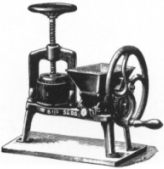Cyder
![]()
 What is
it?
What is
it?
Cyder, which can also be spelt Cider, is the fermented juice of apples to which is added sugar for sweetening purposes. It is therefore a wine made from apples and the process of manufacture is similar to wine making.
It is thought that cydermaking was introduced into England by the Normans. It is believed that the art came to France via the Asturias district of Spain, that the Moors brought it to the latter country, and that it was known to the ancients. Pliny mentions it, and in the "Dictionary of Greek and Roman Antiquities" it is known as "hydromelum".
There is a long tradition of cyder making in England. The first documentary evidence of cyder making comes in the reign of King John, for cyder was being made in Norfolk (Acle district) in 1205. In 1282, there are references to cyder making near Richmond in Yorkshire and later in Kent, Surrey, Sussex, Suffolk and Buckinghamshire, as well as in the West Country.
Cyder was produced in substantial quantities on farms. Every farmer's wife would have a few cyder apple trees as well as dessert and cooking apples in her orchard, and it became a tradition in the 18th Century to pay part of a farm labourer's wages in cyder. A typical allowance on a farm would be 3 to 4 pints per day, increased to 6 to 8 pints during haymaking, and perhaps even more. Labourers were rated by the amount they drank; one comment that a 2 gallon (i.e. 16 pints) a day man was worth the extra he drank! In the western counties of England in particular, a farm worker could receive something like one-fifth of his wage in cyder. In the latter part of the 19th Century, a campaign to stop payment in the form of alcoholic beverages brought about the addition of a clause to the Truck Act of 1887 which prohibited the payment of wages in this way and so made cyder truck illegal. However, such was the liking for cyder that most farmers, in agreement with their labourers, still continued with this type of payment.
The great heyday of English cyder making came after the middle of the seventeenth Century and thereafter entered a slow decline. The encouragement of cheap gin drinking in Hogarth's time lowered the demand for cyder and among the better classes wine was fashionable. The industrial revolution caused the population to move to the towns and cities and, in the 1890's, the revival of cyder making set in. With the introduction of factories with modern hygienic methods and improved distribution, cyder making gradually moved from the small farm producer to the factory. The decline at the end of the 19th Century was thus arrested, and cyder is now well known and obtainable in any part of the British Isles.
The Gaymer family had been making cyder at Banham, Norfolk, for many generations when William Gaymer (1805-1884)developed the business and founded the present Company. Owing to lack of transport facilities in those days, the factory was moved in 1896 to its present site alongside the railway at Attleborough. In addition to the large business done in the home market, export trade has developed over many years. (The website author can confirm this having come across Gaymers cyder in a Cava in the middle of the small Greek island of Zakynthos!).
Cyder can be made from any type of
apple, although in the West Country it is principally made from special cyder
apples grown in that area. Norfolk and other cyders are made from mixed
varieties of dessert and cooking apples. Some of the best cyder obtainable is
made from such apples by methods handed down from generation to
generation.
The apples are pressed in the Autumn (the Fall). Before pressing, they are pulped up in mills so that the juice is more easily extracted in the hydraulic presses capable of handling about 5 tons an hour. The juice is pumped into large tanks holding about 50000 gallons, where it ferments like wine for about one month. After this it is then "racked" (drawn off), and left to mature for several months before it is blended into the finished product.
At Gaymers in Attleborough, the blending process was automated in 1984 using the latest technology. A pre-programmed computerised system blends the cyders to the correct specification. Gaymers were the first cyder company to use microprocessors for this stage of the manufacture. The blended cyder is then pumped into holding tanks to await filling.
Filling is done into kegs, and large quantities of cyder are also prepared for delivery by tanker to contract bottlers around the UK. Before it closed its operations at Attleborough, the keg line at the Gaymer factory filled around 2000 eleven gallon stainless steel kegs every day on a highly automated production line.
The whole process requires anything up to a year according to the type of cyder produced. The successful cyder firms are largely family firms where traditions and generations of experience play a very important part.
| Welcome Page | Gaymer Index |